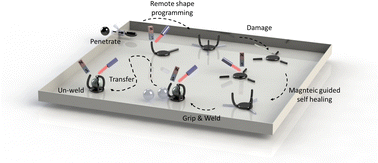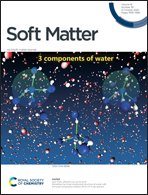Magnetic vitrimer-based soft robotics†
Abstract
Magnetically responsive elastomers, consisting of elastomer embedded with magnetic particles, can produce fast and reversible actuation when subjected to a magnetic field. They have been extensively explored to construct versatile remotely controllable soft robots. Nevertheless, the magnetically induced actuation strain in elastomers is typically small, which limits its broad applications. Recently, magnetic particles have been mixed with viscous fluids to enable giant magnetically induced deformations. However, their response speed is slow and the actuation is usually irreversible. In this work, we have developed a magnetic vitrimer (MV), with magnetic particles mixed with the polymer network containing abundant dynamic covalent bonds. At room temperature, the MV behaves like a regular magnetically responsive elastomer. When the temperature is elevated to the exchange reaction temperature of the dynamic covalent bonds, the material behaves like a viscous magnetically responsive fluid, which can produce large deformations. The embedded magnetic particles and the vitrimer matrix also make the material self-healable without requiring any direct touch. We have demonstrated that with the guidance of an externally applied magnetic field, a MV-based soft robot can pass through a confined space, dramatically change its configuration, self-heal without any contact, catch, secure and release a fast-moving object, and move along a planned path.

- This article is part of the themed collections: Soft Robotics and Soft Matter Editorial Board Highlights of 2022


 Please wait while we load your content...
Please wait while we load your content...